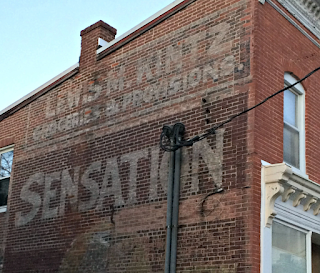Mansion Was Floated Up the Potomac
 |
| Landon House, August 2016 (Google). |
Supposedly, the new owner, the Rev. R.H. Phillips, loved the house but not the location, and had it dismantled and moved 85 miles north, to be reassembled on the Maryland side of the river.
Writing of this legend in 1973, the house’s then-owner, Marion Stancioff, was careful in her assessment:
While there is no known archival documentation to substantiate this claim, the account exists of the dismantling of the house and its subsequent transportation by barge down the Rappahannock and up the Potomac to Point of Rocks and its re-erection on its present site, as given by two nieces of Reverend Phillips who were still living in Frederick in 1949.
Note that those two women, in retelling the events of 103 years previous, could not have been witnesses to the move, but were passing on a family tradition.
Also, Stancioff is clear that the family tradition involved dismantling and reassembling the house, not moving it.
Most of us occasionally have seen a small house, usually a historic one, creeping down the highway on a flatbed trailer while power lines and other obstructions are lifted out of its way. Moving an intact house crosstown is a complicated, expensive feat of logistics, requiring a lot of community cooperation. To move intact a two-story house 100 feet long and 39 feet wide – the dimensions given for Landon House in the 1970s – and to do it over a distance of 85 miles would be nightmarishly difficult even today, much less in the 1840s.
It was not unheard-of, however, in pre-Civil War days for people with money and patience to buy a house, dismantle it, and use its pieces to construct another house in another location. Stancioff is right that this is certainly what happened with the building we know today as Landon House.
Of course, we don’t know how big the pieces were, and whether the operation constituted moving the house is, in the absence of photographs or other documentation, a philosophical question.
We also must note that as with all construction and transportation in pre-Civil War Maryland and Virginia, much of this work, including the sophisticated engineering work, would have been done by slaves, whose contributions traditionally were ignored by historians.
In any case, for years the house had the construction year 1754 mounted on the front porch. Online sources sometimes claim it as an 18th century house, sometimes as a 19th century one. The documented history of the house, however, dates from 1846.
And since the Stancioff family sold the place decades ago, the house has been gutted and renovated multiple times by multiple owners and for a time was, in the words of The Frederick News-Post, “overgrown and dilapidated.” So whether the current Landon House is, indeed, the previous Landon House or yet another reconstruction may itself be a philosophical question.
Today Landon House is surrounded by suburban development, including Landon House Way and Landon House Lane, where a house sold for $470,000 in September 2021.
But the house is still visible to passer-by, most of whom don’t know about its strange history. It’s just north of the Landon Crossing shopping center on Urbana Pike, which is just west of Fingerboard Road, a.k.a. Highway 80. Remember, it’s private property, so look from afar without trespassing.
Sources:
Guynn, Susan. "Five bedroom Villages of Urbana home closes at $975,000." The Frederick News-Post, 18 Sept. 2021. Accessed 18 Nov. 2021 via the Nexis Uni database.
Mullins, Patti Borda. "Landon Village Center plan approved for historic Landon property." The Frederick News-Post, 10 July 2014. Accessed 18 Nov. 2021 via the Nexis Uni database.
“Stancioff House.” Maryland Historical Trust. https://mht.maryland.gov/nr/NRDetail.aspx?NRID=283&FROM=NRMapFR.html. Accessed 16 Nov. 2021.
Stancioff, Marion Mitchell. National Register of Historic Places Inventory – Nomination Form, dated 10 Nov. 1973. Certified by Arthur C. Townsend, State Historic Preservation Officer, 24 Oct. 1974. PDF accessed 16 Nov. 2021 via Maryland Historical Trust. https://mht.maryland.gov/nr/NRDetail.aspx?NRID=283&FROM=NRMapFR.html.

Comments
Post a Comment